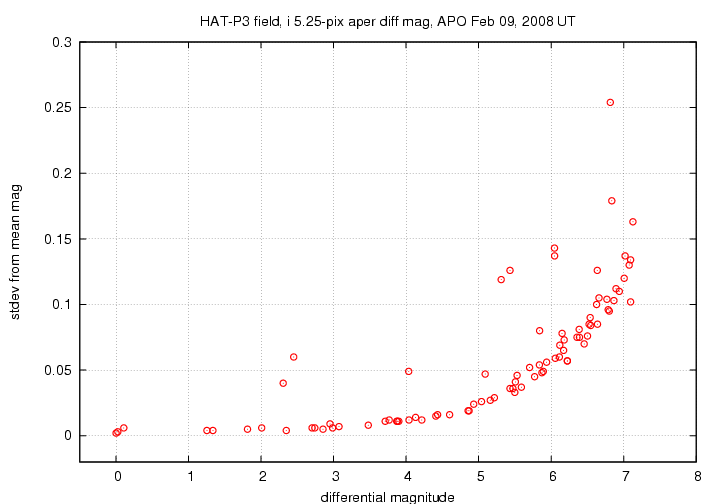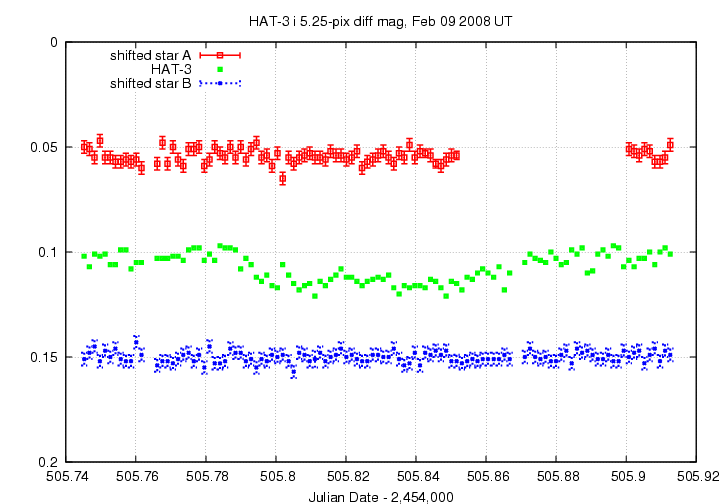
On the night of UT Feb 09, 2008, the SDSS Photometric Telescope ("PT" for short) took a series of exposures of HAT-3. We saw a full transit under good conditions; once again, the ingress seems a tiny bit later than the ephemeris predicts...
Notes from the night
This is a chart of the field. HAT-3 is the bright star indicated by the crosshairs. The labelled stars will appear in later analysis.

As a side note, there are several eclipsing binary stars in this field. The chart below shows three, labelled "X", "Y" and "Z". The one labelled "Y" has an eccentric orbit, as the light curve shown below indicates. North is up, and East to the left.

The host star of HAT-3 has a magnitude V=11.59 according to HAT-P-3b: A Heavy-Element-rich Planet Transiting a K Dwarf Star.
Following the procedures outlined by Kent Honeycutt's article on inhomogeneous ensemble photometry, I used all stars available in each image to define a reference frame, and measured each star against this frame. You can find the software package used to do the ensemble photometry online; it's free!
The night was reasonably clear during the entire run on HAT-3. The graph below shows the amount by which instrumental magnitudes from each image needed to be shifted to match the ensemble reference. On a clear night, this graph would show a straight horizontal line.

Below is a graph of the scatter in differential magnitude versus magnitude in the ensemble solution.

HAT-3 is the star near differential mag 4.9; it shows a small excess of scatter over neighboring stars of the same brightness. The "noise floor" in these measurements is about 0.003 mag -- pretty good for the PT. The three outliers between differential mags 2 and 4 are the eclipsing binary stars Z, X and Y.
Below are the light curves for the target (green symbols) and some comparison stars in the field. The eclipsing binary "Y" is the star at the bottom.

In this closeup, I have shifted the data for two comparison stars to move them closer in magnitude to the target.

I estimate by eye the ingress at about 505.79, and the egress at about 505.88 (with a gentler slope).
An ephemeris grabbed from transitsearch.org predicts for this night
----------------------------------------------------------------------------------------
Begin Transit Window PREDICTED CENTRAL TRANSIT End Transit Window
All Times UT
HJD Year M D H M
2454505.78 2008 2 9 6 41 2454505.83 2008 2 9 7 55 2454505.88 2008 2 9 9 8
----------------------------------------------------------------------------------------
The ephemeris ingress of UT 2008 Feb 09 06:41:00 corresponds to JD 2,454,505.778, which is a tiny bit earlier than I estimated. The ephemeris egress of UT 2008 Feb 09 09:08:00 corresponds to JD 2,454,505.881, just about when my eyeball detects the egress. The very slightly later-than-predicted ingress may not be signficant, but it matches the pattern from three nights earlier.
You can grab the measurements for your own analysis. Below is a table with three flavors of time, plus the differential magnitude of the target and an estimate of the uncertainty in each measurement. I show the first few lines of the file to give you an idea of its format.
# Measurements of HAT-3 made with APO PT, Feb 9, 2008 UT. # Each exposure 45 seconds long in SDSS i-band; # Tabulated times are midexposure (FITS header time - half exposure length) # and accurate only to +/- 1 second (??). # 'mag' is a differential magnitude based on ensemble photometry # using a circular aperture of radius 5.25 arcseconds. # # UT day JD-2,450,000 HJD-2,450,000 mag uncert Feb09.74524 4505.74524 4505.74795 0.102 0.003 Feb09.74673 4505.74673 4505.74944 0.107 0.003 Feb09.74823 4505.74823 4505.75094 0.101 0.003
Last modified 02/24/2008 by MWR.